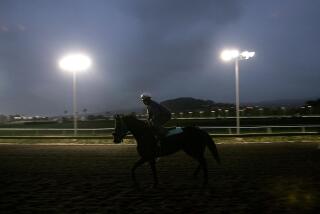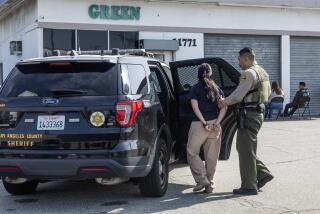Thrills in Store on Safer Track
SAN DIEGO — Nothing -- not the fiery crash that killed his closest friend, not his beautiful baby son, certainly not the police -- can make Edgar Gomez give up drag racing.
The black pavement glistening in the moonlight, the beat of his own heart kicking into high gear, the incredible burst of speed, the intense focus when his foot hits the accelerator -- to him, it’s the best feeling in the world.
Luckily for Gomez, the San Diego Police Department understands this -- to a point. As part of its program against street racing, the city lets him and other speed addicts race in certain spots, such as Qualcomm Stadium, under supervision.
For those who don’t get the message, the police have an undercover unit -- believed to be the only one of its kind in the state -- devoted to stamping out the illegal pastime. They also have stiff penalties for racers and spectators.
There have been 13 deaths related to drag racing in San Diego County this year. Last month the San Diego City Council voted unanimously to make watching an illegal race a crime, punishable by a fine of $1,000 or as much as six months in jail.
The city joined a host of other jurisdictions, including the city and county of Los Angeles, that have enacted such laws in recent months to combat a rise in street carnage. But officials in San Diego say their program goes further.
“Enforcement over the course of history has not worked,” said William Maheu, assistant police chief of San Diego. So officials have pushed legal racing as an alternative, enlisting the parents of children killed in crashes to help make the case that it is just as satisfying to race in a stadium as in the streets.
Officials say their strategy is a success. One year ago, it was not unusual for police to break up races that had drawn 1,200 cars and 3,000 spectators. Now, many illegal races draw fewer than 50 cars. Police hope that number will continue to drop now that it is a crime even to watch, and that drivers will find racing without an audience no fun.
Observers agree that the program has had a chilling effect, but they say it is unlikely to wipe out the problem. The number of deaths and injuries this year -- including a crash that killed two bystanders last month -- underscores that.
“I think their efforts are very good,” said Charlie McCracken, who runs the Web site SDStreetracing.com. “But I just don’t think it will solve any problems.”
Racing, he said, “is never going to stop.”
In San Diego, police and community leaders operate on the assumption that getting into a car and punching the accelerator is not inherently wrong, but that doing it on city streets is. It’s now easier to find a place to race legally in San Diego than almost anywhere else in California -- and the chances of getting caught and punished for doing it illegally are much higher, police say.
The penalties are harsh. Last month, police said, George Waller Jr. was charged with murder after he allegedly killed two teenagers whose car crossed the path of his speeding car. Officials say it is the first murder charge related to drag racing in San Diego County’s history.
The carrot-and-stick approach is being watched by authorities as far away as Germany.
“Drag racing has been going on since the first two Model-Ts came off Henry Ford’s assembly line,” said Stephen Bender, a professor of public health at San Diego State University. “We’re saying ‘Look, that’s fine. The need for speed is there. Take it to a safer venue.’ ”
Bender, who confesses to speeding in his own youth down empty country roads, began studying drag racing as a public health issue in 1997, when he noticed how many kids were dying in car crashes. He got a $2-million grant from the state Office of Traffic Safety and in 1998 began spending 20-hour days setting up the race course at Qualcomm Stadium. Bender calls his program RaceLegal.com. It attracts more than 2,000 spectators and 225 racers on Friday nights. They will be racing every Friday night from now until the end of the year. Racers have their cars checked, don helmets, sign liability waivers and they’re off -- racing as many as 20 times a night.
Bender persuaded judges to send youngsters convicted of drag racing to serve their probation under his tutelage. Some of them have helped out at legal races. Despite these efforts, however, many still prefer the illicit thrill of meeting at gas stations and cruising for the perfect empty industrial park.
So last year, with a $400,000 Traffic Safety grant, the San Diego Police Department formed what it says is the nation’s only unit dedicated to wiping out illegal drag racing.
Its undercover officers prowl the races with cameras and notebooks and then arrest the racers later, often at home in front of their parents. They also work with automotive experts to identify cars that have been illegally souped up, and with city attorneys to prosecute those they catch.
Many racers say the police presence has pushed them off the streets.
“Trust me, a lot of people have quit racing because of that,” Gomez said. “You can’t spot them anymore,” he added. “Before they had Crown Victorias, and we’d be, like, ‘We’re not going to race in front of you, buddy.’ But now they’ve gotten smarter. Now they have imports.”
Greg Sloan of San Diego’s police dragnet unit declined to discuss the department’s strategy or details of the undercover operations.
What he will talk about are the benefits of racing legally. Among those, he listed one of the more painless methods of learning chemistry and physics, and a highly effective anti-drug and alcohol program.
“It teaches you a lot,” he said. Technical know-how is needed to calculate how to modify a car to make it go faster, and lackluster students suddenly begin boning up on math and physics to grasp concepts like velocity and force, he said.
“People put so much time and energy into figuring it out that they don’t spend a whole lot of time when it comes to either drugs or alcohol,” Sloan said. He said he had seen only two bottles of beer in an entire year of busting illegal races.
Such benefits are lost on Peggy Klein Martinez, whose daughter Rebeca died in a car crash in August when a friend took her to an illegal race on their first date. Since her daughter’s death, Martinez has committed herself to raising money and lobbying to create more places where kids can race legally under controlled circumstances.
She has also been to almost every race at Qualcomm Stadium since her daughter’s death, joined by other parents whose children have died. She does it, she said, so her daughter will not have died in vain.
“They offer the kids a place where they can go do this idiotic thing legally and safely,” she said. “If it’s the very last thing I ever do in my life, I will see a track built for these kids.”
More to Read
Sign up for Essential California
The most important California stories and recommendations in your inbox every morning.
You may occasionally receive promotional content from the Los Angeles Times.










